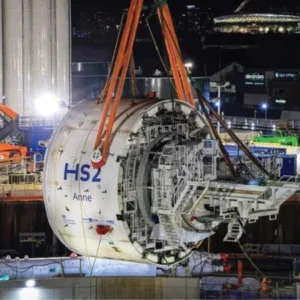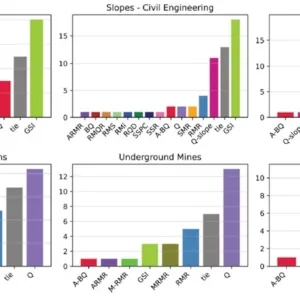CFD (Computational Fluid Dynamics) is commonly applied to verify the performance of ventilation systems in road tunnels and their ability to control smoke from vehicle fires. Often, such tunnels rely on jet impulse fans to induce air and smoke movement in the tunnel. These types of fans, however, are highly focussed in their effect, and so any modelling approach must provide an accurate prediction of the rate at which the high-speed jet flow from the fans mixes with the slower surrounding air. Over-prediction of the jet spreading rate will lead to optimistic (non-conservative) predictions of the velocity at the tunnel mid-plane, and therefore will give misleading indications of the efficiency of the ventilation system.
This paper will use existing knowledge of CFD and turbulent jets and use example CFD simulations to show the current approach that is widely used in this industry (namely a k-epsilon turbulence closure model with relatively coarse grid resolution levels) is inadequate to provide accurate predictions for these types of flows, and will in fact often lead to nonconservative designs. Finally, we will present a more appropriate CFD approach, based on enhanced modelling techniques and current ‘best practice,’ that we believe should form the basic standard for the modelling of such flows.
Smoke in tunnels is often controlled by using a longitudinal airflow in the tunnel to prevent smoke backlayering and to push smoke forward, thus creating a clear path for evacuation and access to the incident for the fire brigade. The magnitude of this flow is often referred to as the ‘Critical Velocity’. Several different means can be used to generate this flow, axial fans, Saccardo nozzles or jet fans. This paper will focus on the last as jet fans are the most commonly used method, and they raise a number of key issues with their modelling.
Traditionally one-dimensional numerical modelling is applied for simple tunnel geometries, when designing the tunnel ventilation system for normal and emergency operations since it is rapid and effective. Nevertheless, for the verification f the ventilation system, for more complex geometries and for scenarios where the efficiency of the fans becomes paramount, the more resource intensive approach of three-dimensional CFD modelling is often necessary in order to show the full flow picture and to predict the smoke control performance of tunnel ventilation systems.
Jet (impulse) fans work by transferring momentum from their high speed jet to the relative slow tunnel air, and so the modeling of the ventilation flow must provide an accurate prediction of the rate at which the jet flow from the fans mixes with the background air. This is particularly important for tunnels of high aspect ratio where the fans are located at the edges of the tunnel (i.e., not over the carriageway) since there is a tendency for the air in the centre of the tunnel to stagnate or even to reverse direction. Accurate modelling means applying the most appropriate tools for the numerical model such as addressing the correct turbulences model and mesh size.
The following case study will use existing knowledge of CFD and turbulent jets to highlight the issue, and focuses on the simulation of high aspect ratio tunnels with jet-fan ventilation systems. The aim is to draw attention to how the widely used approach in this industry (namely a kepsilon turbulence closure model with relatively coarse grid resolution levels) is inadequate in providing accurate predictions for these types of flows, and will in fact often lead to non-conservative designs and overconfidence in the proposed ventilation setup.
Case study
Results are presented here from a CFD assessment of the smoke control performance for a 1,150m long road tunnel equipped with angled jet fans. The tunnel section has an aspect ratio of 3.8:1 (width:height) and is 19m wide. The modelled fire scenario is as follows:
• 50MW total fire power, including radiation (which is assumed to be 30 per cent of the fire power),
• Fire located 85m from the exit portal,
• Stationary traffic all along the tunnel up to the fire location,
• Jet fans located at the upper edges of the tunnel.
For modelling purposes, only the last 350m of tunnel have been modelled. A total pressure boundary has been applied at the model inlet; the pressure value has been derived accounting for the modelled length of the tunnel.
The fire is located 260m downstream of the model inlet, which is sufficient to achieve a fully developed flow field at the fire location. All walls are no slip, impermeable rough walls, with high Reynolds number wall functions. Each jet fan has been explicitly modelled by a pair of positive and negative velocity inlets representing the fan intake and exhaust surfaces. Swirl effects in the jet have been neglected in this study.
Ten per cent of the fans upstream of the fire have been assumed not to be working, due to redundancy requirements in the system design. The pair of fans downstream of the fire has been assumed not to be working due to the high temperature. The vehicles (a mixture of cars and HGVs giving 165 PCU/km) have been modelled as solid blockages.
Radiation effects have not been explicitly modelled, for simplicity, so only the estimated convective part of the fire power (35MW) has been accounted for.
Analysis
The CFD analysis has been carried out taking two different approaches:
• ‘Industry standard’ approach, where a relatively coarse mesh and a linear turbulence model have been used;
• ‘Best practice’ approach, where a suitably fine mesh and a more appropriate turbulence model have been used.
Industry standard approach
In this simulation, the following approach was taken:
• 1.1 million cells mesh, with a base grid cell size of 0.75m;
• Standard linear, buoyancy-enhanced k-epsilon turbulence model.
The mesh is relatively coarse with no refinement in the jet expansion zone. The linear k-epsilon model is probably the most widely used turbulence model in any industry, is the default closure model for most CFD codes, and is often applied indiscriminately to any application without fully understanding its pitfalls.
The results from the simulation are summarised in Figure 1, which shows the velocity magnitude in a cross section halfway between a pair of fans and the extent of the smoke spreading. These plots suggest that the ventilation system is effective in generating a relatively strong, down-tunnel ventilation flow which is sufficient to control the smoke and prevent any upwind migration of smoke from the fire source.
Best practice approach
The analysis has been carried out taking an approach that makes use of best practice for CFD, and so invariably requires more computational effort:
• 13.5 million cells mesh, with a base size of 0.2m,
• Quadratic, buoyancy enhanced k-epsilon turbulence model.
The mesh is a fine, high quality mesh with several levels of refinement in the jet expansion zone. The quadratic k-epsilon model has been chosen as it can correctly capture the most important feature of the flow, namely the round jet expansion ratio. The Ercoftac Best Practice Guidelines ( European Research Community On Flow, Turbulence And Combustion) clearly state that “when using a particular turbulence model, check the published literature with regards to the known weaknesses of the model,” and also that “grids must be fine enough to provide an adequate resolution of the important flow features.”
The above choices were made on this basis. The results from the simulation are summarised in Figure 2 and suggest a different picture; namely that the spreading rate of the jet momentum is not sufficient to ensure a consistent, downtunnel ventilation flow. This means that the central portion of the tunnel does not achieve the critical velocity airflow, the fan efficiency is reduced because of the higher velocity at the fans inlets and, as is shown by the fire simulation, cannot prevent back-layering of the smoke. This is a different picture from the previous section, and would lead the tunnel designers to seek modifications and improvements to the ventilation design.
Comparison of approaches
The previous sections have shown that very different conclusions would be drawn from the two different approaches. The difference can be explained by Figure 3, which shows the predicted spreading rate of a round, free jet for two different turbulence models. It has been known for a long time that the linear k-epsilon model over-predicts the spreading rate of round jets due to a deficiency in the turbulent dissipation for this type of geometry.
Hence, in the industry standard approach there are two mechanisms that work together to artificially spread the momentum effects across the tunnel—the coarse nature of the grid and the poor performance of the selected turbulence model. This leads to a mistaken conclusion that the ventilation system is performing well. Use of best practice, and more computational resources, provides a more faithful picture of conditions in the tunnel and finds that the ventilation system needs improving.
Conclusions
Two CFD fire simulation analyses have been carried out of the same scenario by taking the industry standard approach (coarse mesh, and a linear k-epsilon closure model) and the best practice approach (fine mesh and appropriate turbulence model). The analyses show contrasting results; the industry standard approach finds that the ventilation system is able to control smoke, while the best practice approach shows that backlayering occurs.
The difference is caused by the flaws of the industry standard approach, which leads to erroneous predictions of the ventilation flow field and non-conservative conclusions for cases where the prediction of the jet spreading rate is critical to the ventilation system performance. This is particularly true for large aspect ratio tunnels with jet fans installed in the corner, although on a more general note, computing power is now sufficiently available at a reasonable cost for ‘best practice’ to be applied whatever the geometry.
Figure 1 – Industry standard approach results. Velocity magnitude halfway between a pair of fans (left) and smoke extent (right) Figure 2 – Best practice approach results. Velocity magnitude halfway between a pair of fans (left) and smoke extent (right) Figure 3 – Graph of predicted spreading rate for turbulent, round, free jets with standard and non-linear k-epsilon closure models, compared to experimental test data.






